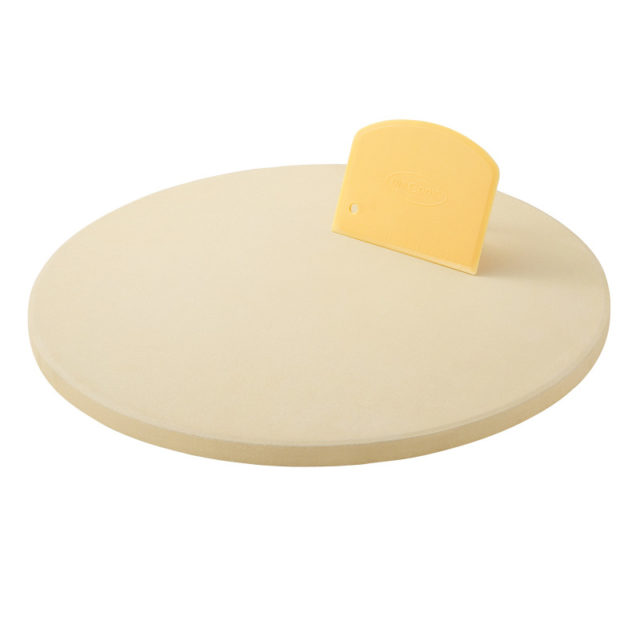It’s our favorite time of the year! Christmas is around the corner and we are thinking about what we will cook. This year we want to make our families taste Italian Christmas food. But what are Italians eating for Christmas? Well, it depends if it’s Christmas Eve’s dinner or Christmas Day’s lunch. But don’t worry pasta lovers, pasta dishes will be involved for sure! Let’s take a closer look at this Natale food.
The traditional Italian Christmas eve dinner
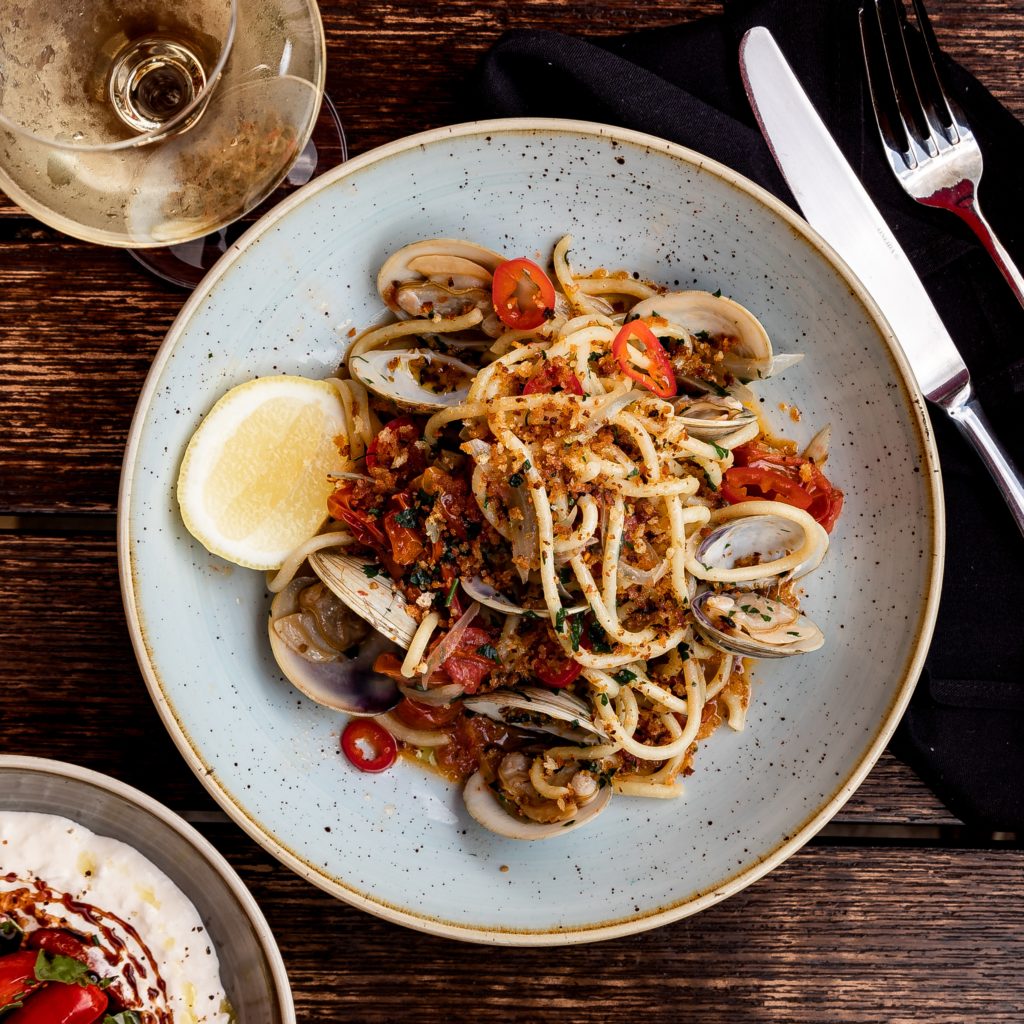
Traditionally, the Italian Christmas Eve food is far lighter than the Italian-American one, as it mainly consists in no meat and a lot of seafood. A bounty of seafood awaits you at the table: succulent swordfish, luscious tuna, octopus and rich salmon. Enjoy delicate calamari or savor linguine topped with a mouthwatering clam sauce. You can taste the famous Italian dish made of salted cod: baccalà. It is the most iconic dish of Venetian cuisine. Centuries ago, Venice was a bustling epicenter of European commerce and it became commonplace to discover salted fish from Norway… That’s how the beloved dish baccalà was created.There’s not only seafood on the Italian Christmas table. In Northern Italy for example, gnocchi and stuffed pasta are a must. You can try gnocchi alla trabaccolara. This traditional Christmas gnocchi was born in Viareggio in the late 19th century. It is originaly a poorman’s dish composed of tasty gnocchi and a fish fumet. And if you are more into stuffed pasta than gnocchi, you can try cappelletti. It is a small stuffed pasta that is part of the Christmas tradition of the Emilia Romagna region in Northern Italy. Cappelletti are usually filled with meat or fish and served in a broth.
A fun twist: the Christmas pizza

While the concept of having pizza for Christmas may seem peculiar, Italians have their own unique and delicious dish – a Sicilian Christmas pizza! This pizza stands out from the rest with its crunchy, bread crumb-covered crust. The key ingredient to our succulent sauce is a mix of onions and anchovies, yet we wouldn’t want you revealing that to your guests – unless you feel adventurous enough! This pizza is a whole new experience with its wet dough and savory sauce. You will love it! For a unique spin on the holiday season, try out this delicious Christmas tree pizza for your kids! To create a festive treat, shape your dough into the form of an evergreen Christmas tree. Get creative and customize your pizza with a one-of-a-kind topping. This is a fun Christmas activity to do with your children! If you are vegetarian, don’t shy away from creating a delicious veggie Christmas pizza with cream and mushrooms. It’s the perfect dish for all your holiday festivities!
What’s for dessert?
Now it is time for the best part: dessert. The most famous Italian Christmas sweet treat is panettone. A beloved Italian Christmas bread created in 1495 during a luxurious Christmas banquet given by the Duke of Milan. It is a fluffy Italian sweet bread filled with candied orange and citron peels. Panettone is so delicious that we are sure you will want to have some all year round! What’s great with this Italian Christmas cake is that many options exist: panettone bread pudding, panettone French toast, and even chocolate panettone!
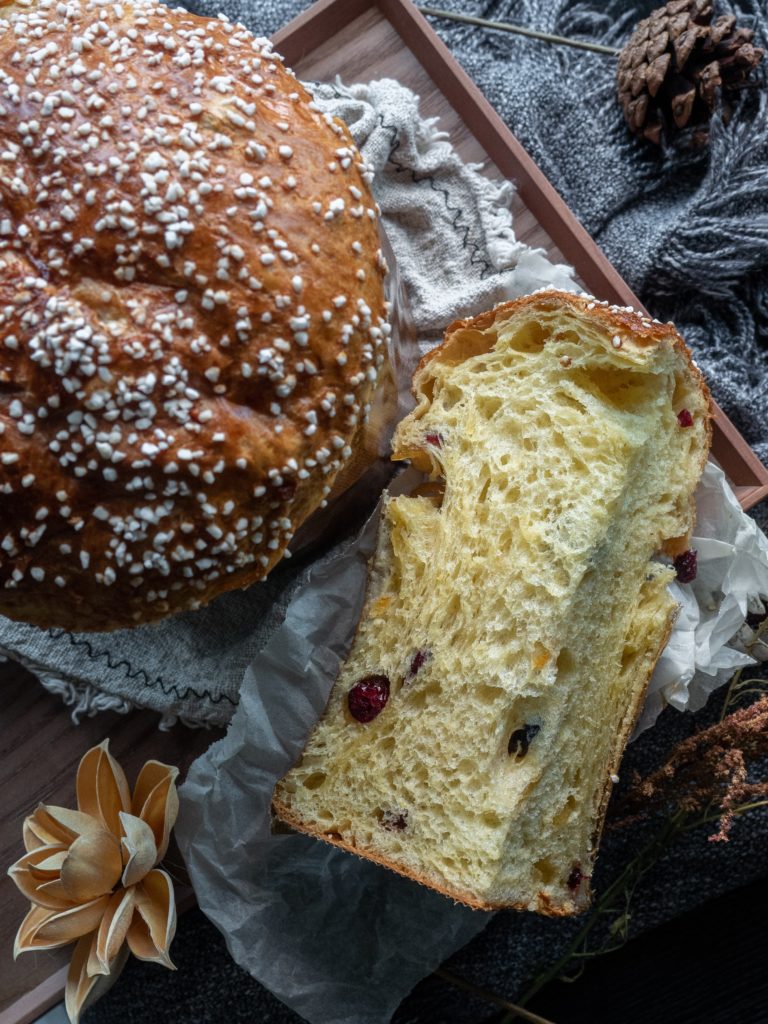
Another Italian dessert that you can enjoy on the holidays is pandoro – golden yellow Italian panettone. It was created in 1894 by chef Domenico Melegatti. This star-shaped cake is made with Italian cake yeast and dry milk, so it is a light and airy cake that you won’t be able to resist!
Biscotti are Italian cookies that are a must-have Italian Christmas dessert. Italian biscotti come in many different flavors, but you can never go wrong with classic Italian almond and pistachio recipes for the holidays. This Italian Christmas cookie comes from Tuscany and became a classic Italian Christmas treat.Now I want to tell you about my favorite: torrone. This Italian nougat is made with toasted nuts and honey – a delicious Italian Christmas candy that you can enjoy for the holidays! The history of this Italian Christmas candy is really interesting because it is believed that it derives from an Ancient Roman treat… But we aren’t sure about that, so some say it comes from an Arabic dessert.
How do you celebrate Natale?
Whether you are more a pasta or a pizza lover, the Italian tradition has a savory dish for you. This year, I want to try to make my own Italian Christmas candies and experiment a torrone recipe. Keep in mind that the most Italian Christmas thing is sharing a good time around the table with your loved ones. Buon Natale from all of us at Pasta Pizza!
There’s no doubt about it: pizza is one of the most popular foods in the world. And when it comes to pizza, Italy is king. Each region of Italy has its own spin on this classic dish, with variations in crust thickness, sauce quantity, and topping choices. In this article, we are going to take a look at the different types of pizza you can find in each region of Italy. So put on your stretchy pants and get ready for a delicious culinary journey!
Neapolitan pizza

Hailing from the region of Campania in southern Italy, Neapolitan pizza is considered to be the original Italian pizza. It is perhaps the most famous type of pizza in the world!
This style of pizza is characterized by a thin crust and a generous amount of tomato sauce. These days all rules have been bended, but if you want to stick to the classic Neapolitan pizza then you must stick to basic toppings, like fresh tomatoes, cheese and basil. An authentic Neapolitan might also allow you to add some prosciutto or mushrooms, but don’t try push it any further than that! Neapolitan pizza is about tasting the fresh ingredients, not about finding complex flavor combinations.
Neapolitan pizza is cooked in a wood-fired oven at high temperatures, which gives it a unique flavor that you can’t find with other types of pizza. Because the oven is so hot and the crust is so thin this type of pizza also cooks incredibly fast, as in under 60 seconds in some cases.
Roman pizzas
Naples might be the city were pizza originated, but Rome is the capital of Italy, and so they had to have not one but two types of pizza which can be considered roman pizzas.
Pizza al taglio
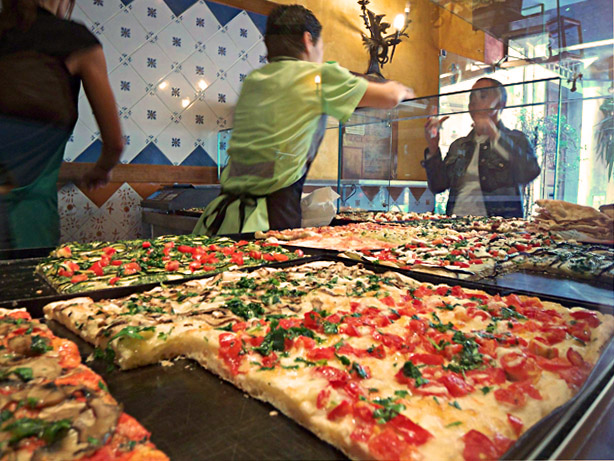
The first type of roman pizza is pizza al taglio, which translates as “pizza by cuts”. It’s usually rectangular in shape and is sold by weight. It is meant to be eaten with your hands, usually standing up or even while walking.
Pizza al taglio is characterized by a very soft crust which is almost doughy in texture, similar in a way to focaccia. This type of pizza is also usually cooked in a metal pan instead of a wood-fired oven, which gives it a slightly different flavor. It is usually topped with fresh vegetables, cheese, and cured meats, although there are endless possibilities when it comes to toppings.
You’ll usually find this type of pizza in bakeries or small stands, rather than restaurants, and it tends to be quite inexpensive.
Pizza tonda
The second type of Roman pizza is the pizza tonda. it’s a traditional round pizza that is usually served in pizzerias. This type of pizza has a thin and crispy crust, and is usually topped with tomato sauce, mozzarella cheese, and pepperoni or sausage.
Pizza tonda is cooked in a electric oven rather than a wood-fired one, which gives it a slightly different flavor. The dough is also allowed to rise for a bit longer than in the Neapolitan pizza.
Sicilian pizza
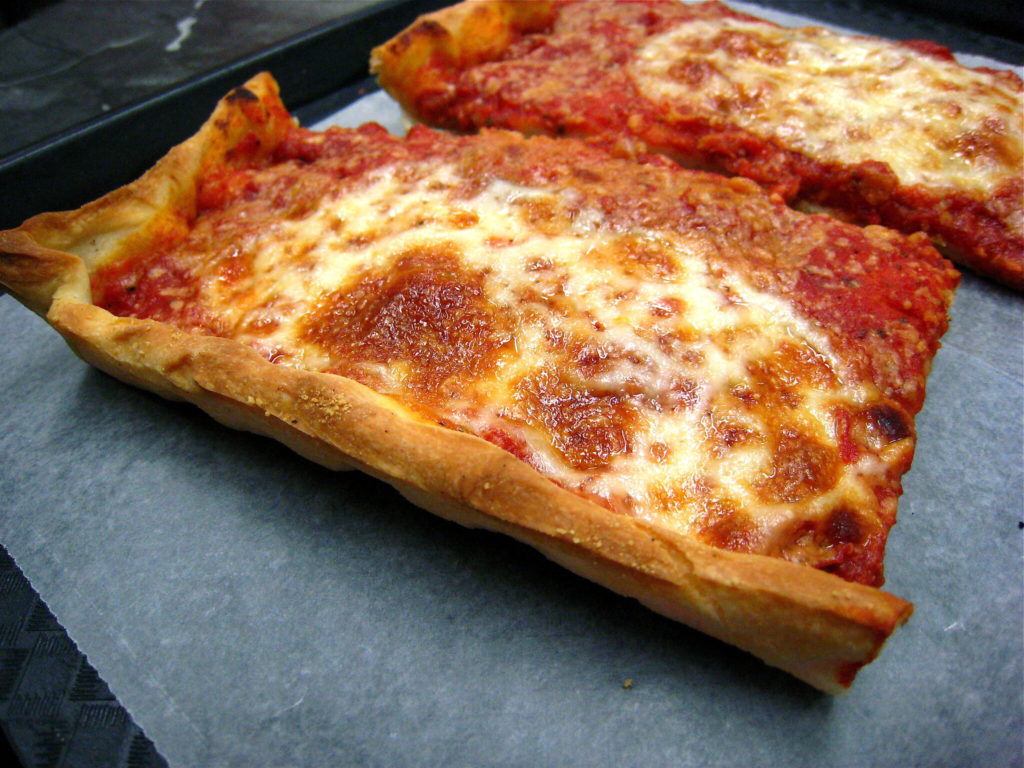
Sicilian pizza, or sfincione, is a type of pizza that originated in the region of Sicily. It is characterized by a thick and spongy crust, which is usually about an inch thick. The dough is also pre-baked before toppings are added, which gives it a crispy texture.
The most traditional toppings for Sicilian pizza are a tomato sauce, onions, caciocavallo cheese, and anchovies. However, these days you can find Sicilian pizzas with all sorts of different toppings.
Sicilian pizza is usually cut into small square pieces, rather than being sliced like a traditional round pizza. This makes it easy to eat on the go, and is also perfect for sharing!
Tuscan pizza
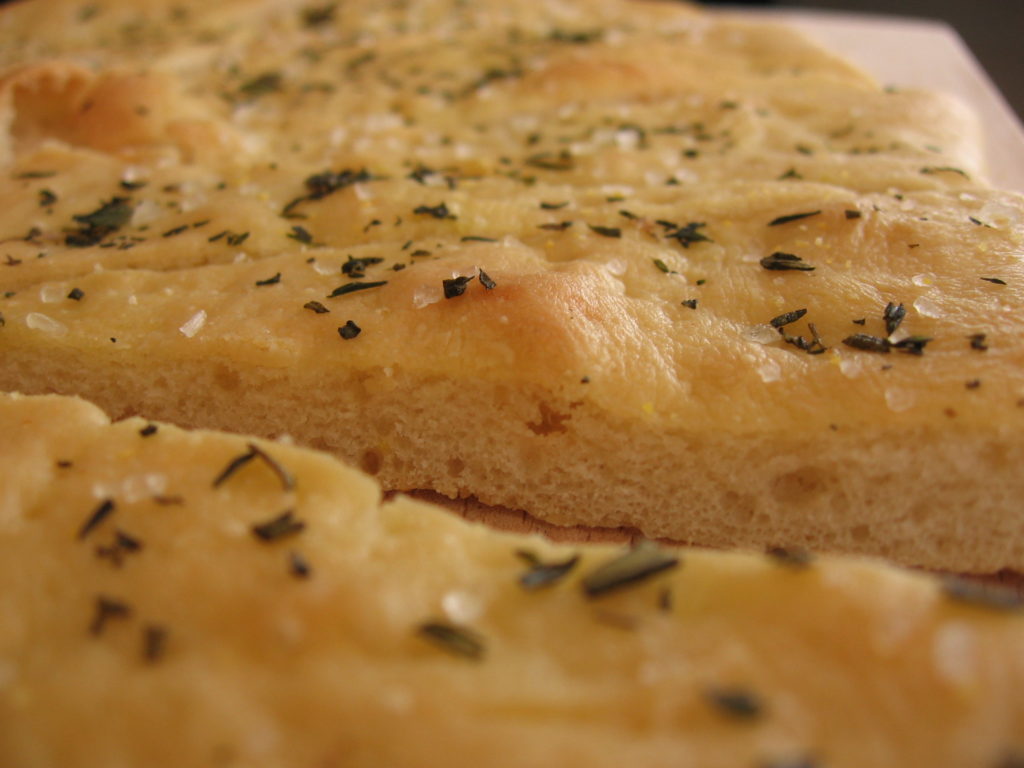
Tuscan pizza, or schiacciata, is a type of flatbread that is popular in the Tuscany region of Italy. It is usually made with a simple dough of flour, water, salt, and yeast, and then topped with olive oil and garlic. Sometimes other toppings like tomatoes or onions are added, but the most traditional schiacciata is simply topped with olive oil and garlic.
This type of pizza is usually quite large, and is meant to be shared. It is cooked in a wood-fired oven, which gives it a slightly charred flavor. The dough is also allowed to rise for a longer period of time than other types of pizza dough, which makes it nice and fluffy.
Ligurian pizzas
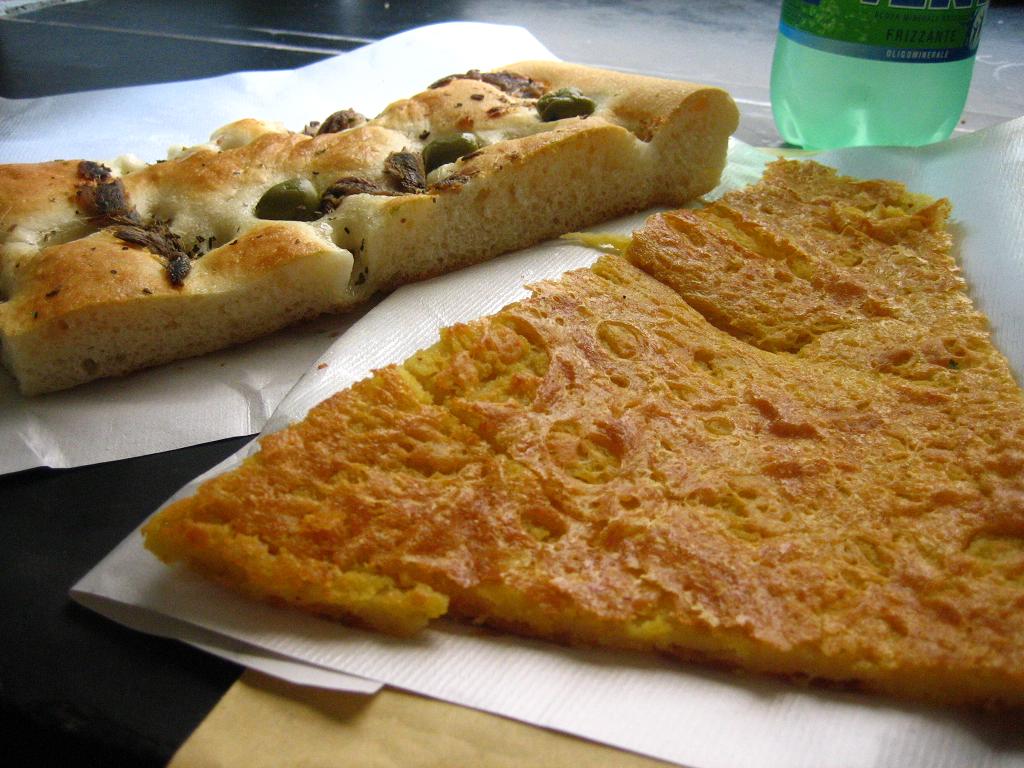
If you find yourself in the northwestern region of Italy then you’ll be able to try two delicious types of pizza from the Liguria region.
Focaccia
The first type of pizza is focaccia (where does focaccia end and pizza begin is a debate for another time), which is a flatbread that is similar to Tuscan pizza. It is usually made with a dough of flour, water, salt, and olive oil, and then topped with herbs like rosemary or sage. Sometimes other toppings like olives or cheese are added, but the most traditional focaccia is simply topped with herbs.
Focaccia di recco
The second type of Ligurian pizza is focaccia di recco, which is a type of flatbread that is filled with cheese. It is made with a dough of flour, water, salt, and olive oil, and then filled with fresh cheese. The dough is then rolled out thin and cooked in a wood-fired oven.
The cheese filling makes focaccia di recco quite rich, so it is usually served in small pieces. The dough is also quite thin, so the cheese filling is really the star of this dish.
As you can see, there are all sorts of different pizzas to be found in Italy. Each region has its own unique spin on this classic dish, so be sure to try as many different types as you can when you’re in Italy! I would personally love to take a road trip around Italy one day just to discover all their regional pizzas!
If you’ve visited New York or lived there, you probably heard of the “Brooklyn style pizza”. You already knew Detroit already had its own style of pizza, but never heard that Brooklyn also had!
But what’s the story behind this special pizza? What ingredients make it so special, and where can you taste it? Keep reading to know what is Brooklyn style pizza.
The History of Brooklyn Style Pizza
Brooklyn style pizza can be traced back to the early 1900s, when immigrants from Italy started arriving in Brooklyn. These new residents brought with them their love of pizza, and began opening up pizzerias around the borough. Coal-fired ovens were common in many homes and businesses in Brooklyn at this time, and so these new pizzerias began cooking their pies in these ovens. The result was a thinner, crisper crust than what was typically found on other types of pizza.
The thin and cripsy crust is also a trait of the traditional Neapolitan pizza, that we can guess immigrants replicated in Brooklyn.
Fun fact: the pizza was originally introduced in America in the city of New-York by Italian immigrants… before the pizza fever spread all over the country!
As the years went by, more and more people started flocking to Brooklyn to try this new style of pizza. Indeed, we have to remind you that the American pizza has a lot of differences with its Italian cousin!
Soon, it became one of the most popular pizzas in New York City. Today, you can find Brooklyn style pizza all over the world, and it has become one of the most iconic types of pizza out there.
Brooklyn Style Pizza vs. New York Style Pizza: What’s the Difference?
When it comes to pizza, there are two main types that come from New York: Brooklyn style and New York style. So, what’s the difference?
Brooklyn style pizza is typically made with a thinner crust than other types of pizza. It is also cooked in a coal-fired oven, which gives the crust a crispy texture. Brooklyn style pizza is also usually topped with a variety of fresh vegetables and meats, rather than the traditional mozzarella cheese.
New York style pizza, on the other hand, is typically made with a thicker crust. The dough is hand-tossed and it is cooked in a gas oven, which gives the crust a chewy texture. New York style pizza is typically topped with mozzarella cheese and a few simple toppings, such as pepperoni or sausage. You usually buy it by the slice, to eat it on the go in your busy Big Apple day!
The ingredients of the Brooklyn Style Pizza
The dough is typically made with bread flour, water, salt, and yeast.
Unlike traditional mozzarella cheese-topped pizza, Brooklyn style pizza is generally topped with a variety of fresh vegetables and meats. Some popular toppings are onions, peppers, sausage, and ham.
Where can you grab a slice?
If you’re in Brooklyn, there are plenty of pizzerias that serve up this iconic dish.
Grimaldi’s
Founded by Patsy Grimaldi in 1990, this pizzeria located in Dumbo, Brooklyn, uses over 100-tradition pizza cooking in its recipes. It is now a very known pizzeria chain all over the states of North America. We love it for an authentic Brooklyn style pizza, and an authentic Italian experience right under the Brooklyn bridge.
Juliana’s
Considered as the rival of Grimaldi’s, Juliana’s also offers one of the best Brooklyn pizza-style in town. Even the New York Times says it: “The thin-crust pies are exceptional, especially with arugula and pepperoni, and the mystique of the original hand-built, blazingly hot hearth — the first coal-fired oven commissioned in New York in over 50 years — only adds to the wow.” You’d be wrong not to try!
Di Fara Pizza
It’s frequently mentioned as one of the city’s finest pizzerias by food critics and bloggers. Several publications have dubbed Di Fara “the greatest pizza in New York.” Di Fara is appreciated for using imported ingredients that add more flavor and body to its pies. Today, Di Fara’s still sells NYC’s most expense slice at $5.
Some of the most popular places also include L&B Spumoni Gardens, and Totonno’s Pizzeria Napolitano.
If you’re not in Brooklyn, don’t worry! You can still enjoy Brooklyn style pizza. There are plenty of pizzerias around the country that serve up this delicious dish. So, if you’re ever in the mood for a slice of Brooklyn style pizza, be sure to check out one of these pizzerias.
Pizza ovens can reach temperatures of up to 900 degrees Fahrenheit (480+ Celsius). This is key to create the perfect pizza crust.
Now, most of us don’t have access to a pizza oven. And even though you probably don’t know the max temperature of your home oven from the top of your head, let me tell it will probably maxes at 405 ºF, or even lower. That means your domestic oven However, will, at best, reach a maximum temperature that’s half of what a professional pizza oven produces.
With that in mind, it shouldn’t come as a surprise to learn that it is very hard to cook a restaurant-like pizza at home. That doesn’t mean your homemade pizza is bad, it will just be different, because it will have been cooked differently.
That being said, there is a very simple tool that can help us achieve better results. That is the Pizza Stone, or Oven Stone. In this article we are going to look at how this simple gadget can help you take your homemade pizza to the next level, and also learn a couple tricks about how to use it.
How does it work and why does it make better pizza?
Using a pizza stone is really simple. The only thing you need to do is put the stone in the oven beforehand and preheat it for about 30 minutes. Then put your pie on the stone and back into the oven. That’s it!
The reason why a pizza stone will help you achieve a more professional pizza using your home oven is because after preheating the stone, it will transfer this heat directly to your pie. The more heat you can concentrate on you pizza the quicker it will cook and the closer it will be to the one you’ll expect to get at a restaurant.
But that’s not the only reason. When we cook pizza in our home oven, we often do so on a metal pan or tray, which isn’t permeable and does not allow for the moist in the dough to dissipate. This is the main reason why the dough of our homemade pizza usually ends up being a bit soggy.
The pizza stone on the other hand is porous. This porous will capture part of that excess moisture in your dough, making it drying and crispier.
What is the Pizza Stone made off?
Originally, Pizza Stones were, as the name suggests, made of stone. Slate stones or other kind of flat stone would be use as the cooking surface of wood ovens in Italy.
As you can imagine, domestic pizza stones are not made of stone these days. The material they are made of can vary, some are ceramic, but the best ones are usually made of cordierite or a similar material. That’s because cordierite can withstand high temperatures without breaking, and it is also a very good heat conductor.
Is a Pizza Stone expensive?
The best thing about the Pizza Stone is that it is not expensive at all!
They come in different shapes (square or round), and in different sizes. As mentioned they can also be made of different materials. And there’s a variety of brands to choose from of course. But generally speaking you can get a high-quality 12inch pizza stone for under 30 bugs, and it will last you a lifetime!
$28.97Buy now!
Not just made for the oven
This is one of my favorite things about oven stones. Even though they are called OVEN stones, they aren’t just made to be used in ovens. An oven stone is simply a cooking surface that can withstand very high temperatures. The oven of course achieves this, but you can also use your stone directly on a bonfire, or on top of your BBQ.
This makes the oven stone the perfect accessory for outdoor parties and even camping.
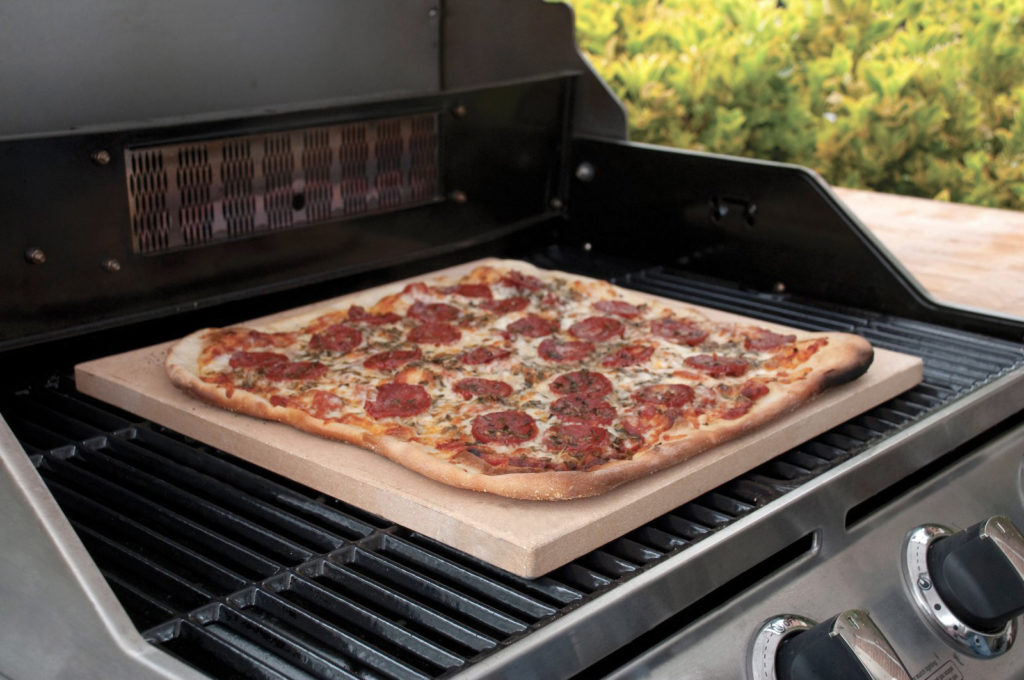
But wait, there’s more! Depending on the type of BBQ you have, whether it’s electric or gas powered, you’ll find that your BBQ might be able to achieve higher temperatures than your oven. This means that cooking your pizza in the BBQ with a pizza stone might produce even better results than cooking it in your kitchen oven. The same is true for bonfires. Depending on what type of wood or charcoal you are burning, you’ll be able to achieve much higher temperatures than in your kitchen.
Some tips for using your pizza stone
- This might sound stupid, but it happened to me, so I’ll go ahead and say it. Make sure you buy a pizza stone that fits your oven! As much as we might like the idea of making a big pie for the whole family that might just not be possible in a kitchen oven. We might end up having to make a few smaller pies instead. Also remember that the bigger the stone, the heavier it would be, and they are heavy, so a large stone might be difficult to work with.
- Preheat your oven with the stone inside for at least 30 minutes. The hotter the stone is the more heat it will be able to transfer to the pizza. You might want to consider putting it on the highest rack of your oven and turning on the grill mode if you oven has one.
- DO NOT season your pizza stone. Make sure to read the recommendations of your stone manufacture, but in most cases you shouldn’t add oil, butter or any other seasoning to your stone. The pores of the stone will absorb whatever substance you put on it, possibly burning it and producing lots of smoke, which will in turn also transfer an undesired taste to your pizza.
- For the same reason, DO NOT clean your stone with soap or any other chemicals. If you do, traces of these products will remain in the stone and will transfer to your pizza. Use only a spatula to remove any burned cheese or toppings that might have fallen off and rinse with water only.
- Last, do not use cooking paper or oven mats on top of your stone. Even though the heat will still transfer to your pizza though these surfaces, they will prevent the moisture of the dough to be absorbed by the the stone.
If you’re an experimented pizzaiolo or simply a pizza lover used to cook pizza at home, pizza seasoning must be familiar. This mix of dried herbs and spices is a unique way to add epic flavor to your favorite pizza: Margherita, pineapple pizza, quatro formaggi (four cheese)… pizza seasoning can be the secret ingredient to enhance your homemade pizza. Whether you’re using it to season your pizza dough, pizza sauce, or pizza stone, this versatile seasoning will take your game to the next level!
But what kind of pizza seasoning should you use? And how? Here are a few of our favorites!
What seasoning is good on pizza?
Pizza seasoning is typically made of a mix of dried herbs and spices. Wether they come from the store or you make them at home, pizza seasoning is equally tasty and flavorful.
There are a few different types of seasoning that work well on pizza. One type is savory, like garlic or onion powder. This goes well with pizza toppings such as meats and cheeses. For instance, you could use garlic or onion powder on pepperoni or barbecue pizza.
Oregano or basil is also much used as pizza seasoning. We like to use them with toppings like tomatoes and other vegetables. They are usually used on Margherita pizza or a veggie pizza!
The last type is hot, like crushed red pepper flakes or cayenne pepper. This goes well with anything really, as it enhances flavors and brings a bit of spiciness!
But in the end, the best pizza seasoning is the one that you like the most! Experiment with different combinations until you find your perfect blend.
Is pizza seasoning the same as Italian seasoning?
Pizza in Italy and pizza in America are not the same, from the way they are baked to the ingredients used and their cooking methods. And again, pizza seasoning used in the United States is not the same as Italian seasoning. Italian seasoning is a blend of herbs that are typically used in Italian cooking. These herbs are usually basil, oregano, rosemary, and thyme.
Pizza seasoning is a blend of herbs and spices that are specifically designed to enhance the flavor of pizza. It is very much used in pizzeria in the States, but rarely in Italy. It can be made of these herbs, but it also typically includes other spices like garlic powder, onion powder, and crushed red pepper flakes.
How do you use seasoning for pizza…
…in the sauce?
To use pizza seasoning in the sauce, simply add it to your tomato sauce or pizza sauce recipe. We like to add a teaspoon or two of seasoning per pound of tomato used. Don’t forget to cook the sauce before using it on your pizza, as the herbs will need time to release their flavors! This will give your sauce a nice flavor boost.
…in the crust?
If you want to use pizza seasoning in the crust, we recommend adding it to the dough recipe. You can add a teaspoon or two of seasoning per pound of flour used. Obviously, knead the dough well on your countertop before shaping it as your pizza base, so the spices blend equally in the entire dough. If you want to add a unique sweetness to your crust and also make it softer, you can also use a teaspoon of honey! This should give your crust a nice flavor boost!
…with a pizza stone?
If you’re using a pizza stone, you can season it with pizza seasoning to help prevent sticking and to give it a nice flavor. A pizza stone is a great way to get a crispy crust, so we recommend using it if you can! To season your pizza stone, simply sprinkle it with some of the seasoning and rub it in with a paper towel. Be sure to do this before adding your dough, as you don’t want to contaminate it. Seasoning your pizza stone is a great way to get a flavorful and crispy crust!
Where can you buy seasoning for pizza?
Pizza seasoning is readily available in most supermarkets, like Wholefoods or Walmart. You can usually find it in the spice aisle. If you can’t find it there, try looking in the Italian section. You can also buy pizza seasoning online. Amazon for instance sells a lot of pizza seasoning recipes, but you can also find them on specialized food stores. There are a number of websites that sell it, so you should be able to find what you’re looking for with a little bit of searching.
Honey on pizza?! You might think that sounds a bit strange, but trust us, it’s delicious! Honey can be a great way to add a touch of sweetness to your favorite dish. It’s actually used many different ways in pizza recipes, so you can experiment to find the perfect combination for your taste buds. Let’s take a look at some of the most popular ways to use honey on pizza!
Is Honey Good With Pizza?
Honey has been used as a natural sweetener for centuries, and it’s only logical it comes associated with such a popular dish as pizza. Even though it might sound like the two don’t match together, honey can actually be used in a variety of ways to enhance the flavor of your favorite dish. Whether you drizzle it on top after cooking like a very original topping or use it in the dough for a sweet crust, honey is a delicious way to change up your pizza night routine.
Still not convinced? Keep reading!
What are the ways of using honey on pizza?
1. Honey can help to balance the flavors in your pizza.
If you find that your pizza is a little too salty or acidic, honey can help to balance out the flavors. This is because honey is naturally sweet, which can help to offset any harshness in the other ingredients. Just a small drizzle of honey can make a big difference in the flavor of your pizza!
2. Honey can add a touch of sweetness to your pizza.
If you want to add a little extra sweetness to your pizza, honey is a great way to do it! Simply drizzle some honey on your pizza after it comes out of the oven. The honey will melt and spread across the top of the pizza, adding a delicious sweet taste. You can also brush honey onto the crust before baking for an even sweeter flavor.
3. Honey can help to tenderize the crust of your pizza.

If you find that your pizza crust is a little too tough, honey can actually help to tenderize it! Honey is a natural humectant and can help to keep things moist. Just a small amount of honey added to your dough can make a big difference in the texture of your crust.
4. Honey can add a beautiful golden color to your pizza crust.
If you want your pizza crust to have a beautiful golden color, honey is a great ingredient to use! The very light golden color of honey can transfer naturally to your dough when it’s used. This can give your pizza an extra bit of visual appeal, making it even more tempting to eat!
5. Honey can help to preserve the freshness of your pizza.
If you’re looking for a way to keep your pizza fresh for longer, honey can actually help! This is because honey is a natural antimicrobial, which means that it can help to prevent the growth of bacteria. By adding a small amount of honey to your pizza dough, you can help to keep your pizza fresh for longer.
Does honey go on pizza before or after cooking?
It’s up to you! You can add honey before or after cooking, depending on your preference. If you want the honey to melt and spread across the pizza, add it after cooking. If you want the honey to infuse the dough with sweetness, add it before cooking.
What if you cooked a honey pizza dough?
If you’re looking for an extra sweet pizzeria-style pie, try cooking your dough with honey. Just add a few tablespoons of honey to your favorite pizza dough recipe. The honey will add sweetness and depth of flavor to the dough, and make it extra soft and fluffy. Pizza dough with honey usually cooks up a bit darker than regular dough, so keep an eye on it while it’s in the oven.
What are the best combinations of pizza toppings with honey?
There are endless possibilities when it comes to flavors and toppings for honey pizza. But if you’re looking for some inspiration, here are a few of our favorite combinations:
Honey and pepperoni
The sweetness of the honey pairs perfectly with the spicy pepperoni. This actually work for every type of salty delicatessen: salami, ham… Add some extra honey on top after cooking for an extra sweet kick.
Honey and mustard
This is a classic flavor combination! Honey and mustard sauce is already very popular as a salad dressing, but this combo also works great on pizza. Try using a honey mustard sauce or topping your pizza with sliced ham and a drizzle of honey.
Honey and cheese
The saltiness of the cheese pairs perfectly with the sweetness of the honey. This is true for every kind of strong flavor cheese: parmesan, provolone, goat cheese, gorgonzonla… If you can’t choose, you can always drizzle honey on your classic 4 cheese pizza before cooking! Add a few red pepper flakes for a bit of heat.
Honey and garlic
Garlic and honey is a classic flavor combination that tastes great on pizza. Try using a garlic-infused honey or adding some chopped garlic to your favorite pizza dough recipe.
Honey and berries
It’s impossible not to mention sweet pizza recipes in this post about honey! Honey is indeed a great sweetener on regular pizza, but it is also a very good topping on sweet pizza recipes. Honey and fresh berries, like blueberries or blackberries is a tart combo that is delicious on pizza. Try using a berry jam or fresh berries as a topping, and add a drizzle of honey on top.
Honey and chocolate
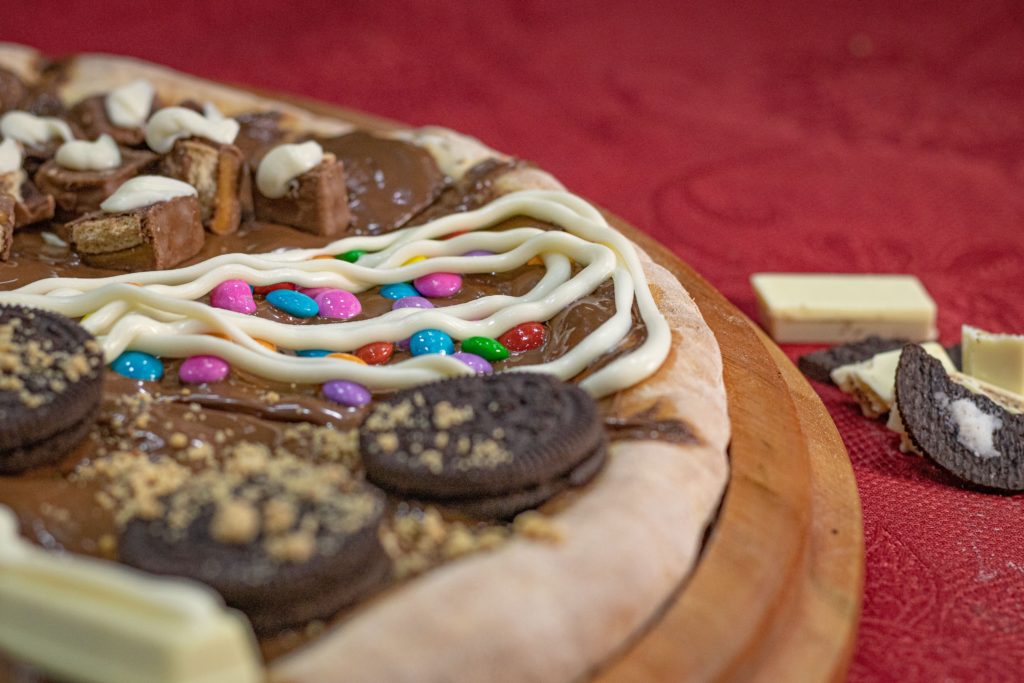
This sweet and rich combo is amazing on pizza. Try using a chocolate hazelnut spread or topping your pizza with chocolate chips and a drizzle of honey.
There are endless possibilities when it comes to flavors and toppings for honey pizza. So get creative and experiment with your favorite combinations! You’re sure to find a new favorite way
If you’re a pizza lover, you’ve probably had both Italian and American pizza. They are indeed two of the most popular types of pizzas in the world. But how can you tell the difference between the two?
While they may both be made with dough, tomato sauce, and cheese, there are some key differences that set them apart. In this guide, we’ll show you how to tell the difference between Italian pizza and American pizza, and navigate you through the history of pizza in the States.
How America created its own version of the Italian pizza
Pizza was first created in Naples, and it wasn’t until the late 1800s that it made its way to America. At first, pizza was only popular among Italian immigrants in large cities like New York and Chicago. But it wasn’t long before Americans started to create their own version of the dish.
Pizza started to be popular in the States in the early 1900s. At that time, there were two types of pizzas: those made by Italian immigrants, and those made by Americans. The difference between the two was mainly in the dough. Italian pizza dough is thin and crispy, while American pizza dough is thick and chewy.
As time went on, Americans began to experiment with different toppings and sauces. Now, American pizza is drastically different from authentic Italian pizza, and every ingredient can change from the traditional recipe.
So what, are the main differences between American pizza and Italian pizza?
Italian pizza vs American Pizza : the main differences
The difference in the crust
As we’ve mentioned, the dough is one of the main things that sets Italian and American pizza apart. Italian pizza dough is made with flour, water, salt, and yeast. It’s then rolled out very thin and cooked in a wood-fired oven at a high temperature. This results in a crispy crust that’s not too thick or doughy.
American pizza dough, on the other hand, is made with flour, water, salt, yeast, and sugar. The sugar makes the dough rise more, resulting in a thicker crust that’s soft and chewy. It’s then cooked in a metal pan at a lower temperature.
The difference in the toppings
Another key difference between Italian and American pizza lies in the choice of the toppings. Traditional Italian pizza is usually topped with a simple combination of tomatoes, mozzarella cheese, basil, and olive oil. This is the most authentic Italian Pizza called Margherita Pizza. Some popular variations include the addition of anchovies, mushrooms, or ham.
American pizza, on the other hand, is often loaded with toppings. Common toppings include pepperoni like in the Detroit Pizza, sausage, onions, peppers, and olives. Often times, there will be multiple toppings on one pizza. And while cheese is still a common ingredient, it’s not used as liberally as it is in Italy.
The difference in the sauce
The sauce is another area where Italian and American pizza differ. Italian pizza sauce is made with tomatoes, garlic, basil, and olive oil. It’s then cooked for a long period of time to allow the flavors to meld together.
American pizza sauce is also made with tomatoes, but it often contains additional ingredients like onions, peppers, and herbs. It’s not cooked for as long, so it has a brighter flavor.
The difference in the cheese
Finally, the cheese is different on Italian and American pizza. Italian pizza is typically made with mozzarella, which is a soft, white cheese. American pizza is often made with cheddar or pepper Jack, which are both harder cheeses. Usually American pizza is also more salty because of the addition of these cheeses.
The difference in the cooking method
The last major difference between Italian and American pizza is the cooking method. As we mentioned, Italian pizza dough is cooked in a wood-fired oven at a high temperature. In Italian restaurants, pizza is cooked for approximately 60-90 seconds in a pizza oven, between 800 and 900 degrees Farenheit (426 to 482 degrees Celsius). You can’t get that hot in your home oven, but the higher you can go, the better.
American pizza, on the other hand, is cooked in a metal pan at a lower temperature. This creates a softer crust that’s not as crispy. The cooking time is also longer, usually around 10-12 minutes.
So what’s best? Italian Pizza or American Pizza?
At the end of the day, it’s up to you to decide which type of pizza you prefer. Both Italian and American pizza have their own unique flavor and texture. If you’re looking for a traditional pizza experience, then you’ll want to go for an Italian pizza. But if you’re looking for something a little different, then an American pizza might be more up your alley.
As any pizza fan already knows, one of the beauties of pizza is it’s versatility, allowing anyone to make it their own. And not just anyone as in Betty your neighbor on the second floor. Countries, and even cities within a country have adapted the traditional Italian pizza to their liking, creating variations such as Mexican pizza, Greek pizza and so on.
In most cases it’s all about the topics. Each country/city/culture will change the toppings based on what they have in abundance. Seaside locations will add sea-food to their pizza, in tropical countries they will add fruits, etc. Sometimes the dough might also vary, but mostly in its thickness.
Detroit however really spined the traditional pizza beyond the toppings, creating something very unique, which most of the people who try it immediately fall in love with.
What makes Detroit-style pizza unique?
Detroit style pizza is a unique type of pizza that was invented in Detroit, Michigan in the late 40s. It is known for its intense flavor and unique texture.
One of the things that makes Detroit-style pizza special is it’s thick crust, very oily, similar in a way to the Italian focaccia, that gives it a unique spongy texture.
Another characteristic that makes it unique is it’s shape. Typically cooked in steel pans Detroit-style pizzas are usually square.
But there’s more. Detroit flipped their pizzas upside down! Instead of following the traditional order of dough-sauce-cheese-toppings they do dough-toppings-cheese-more toppings-sauce.
The sauce is added last, and when baked it takes flavor from the toppings and the cheese as it makes its way down to the dough.
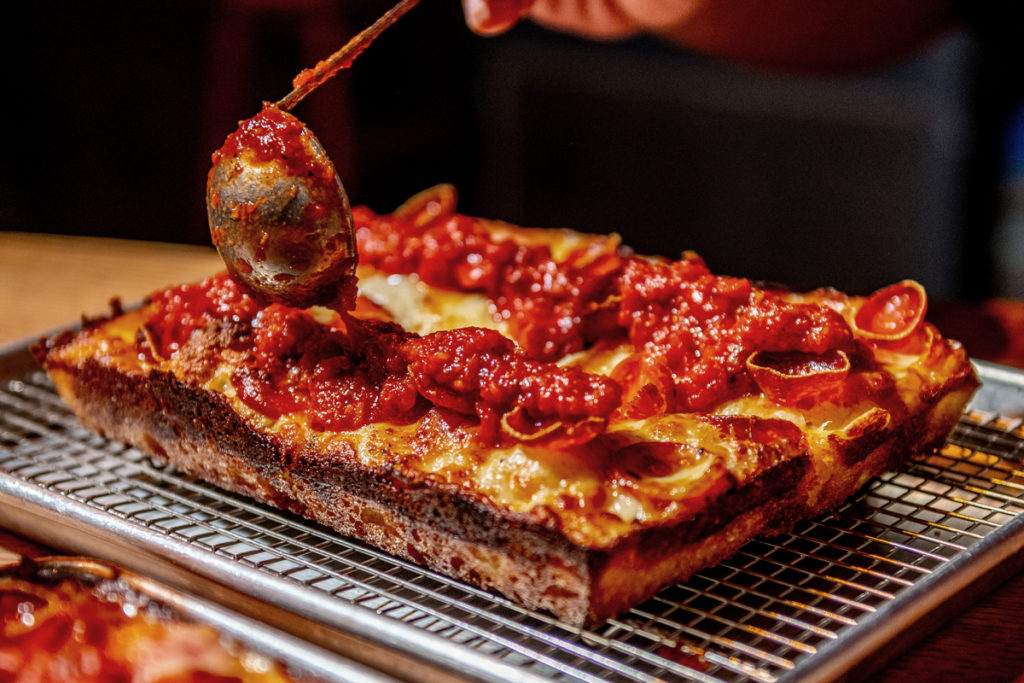
So to recap, if you order a Detroit-style pizza, this is what you can expect.
- A Rectangular shaped pie.
- Thick, focaccia-like crust.
- Inverse ingredient order (dough first, then peperoni, then cheese, then other toppings, sauce goes last).
- Cooked in steel pans.
- Cheese spreads to the walls of the pan, burning and creating a crispy cheese crust.
When did Detroit-style pizza became popular?
The first Detroit-style pizza was created in 1946 by Gus Guerra and his wife, Anna Guerra, who owned a bar in Detroit called Buddy’s Rendezvous. Or at least that’s the most widely accepted version of the story. Back then they didn’t know they were inventing the Detroit-style pizza though, and the term is believed to have been first used on a trade magazine in the 80s.
The pizza became popular within the Buddy’s Rendezvous customers, it even gain some regional popularity, but it didn’t really extend beyond de Detroit area until the 2010s.
In 2011 two Detroit raised brothers now living in Texas decided to open a pizzeria using the term “Detroit-style” in it’s name, and in 2012 several restaurants nation-wide had listed “Detroit-style” pizzas in their menus.
The recipe has been gained popularity ever since. A quick look at Google Trends shows how the term “Detroit-style” pizza” has been consistently gaining popularity over the past few years, with a couple big spikes in interest thanks to some really good press mentions, including GurbHug listing it as one of the top 5 food trends in America in 2021.

So there you have it. A bit of history, and what you can expect if you order a Detroit-style pizza.
If you’re in Detroit, or even if you’re not, and you’re looking for a unique and delicious pizza experience, then you need to try Detroit-style pizza. What are you waiting for? It might just become your new favorite type of pizza!
You won’t be disappointed.
When it comes to pizza toppings, there are a lot of controversial choices out there. But one topping reigns supreme in the debate: pineapple! Some people love it, some people hate it – everyone sure has an opinion about it.
In this article, we’re going to take a look at the story behind pineapple on pizza. Who put pineapple on pizza first? How did it become popular? And most importantly, why do some people hate it so much?
Who put pineapple on pizza first?
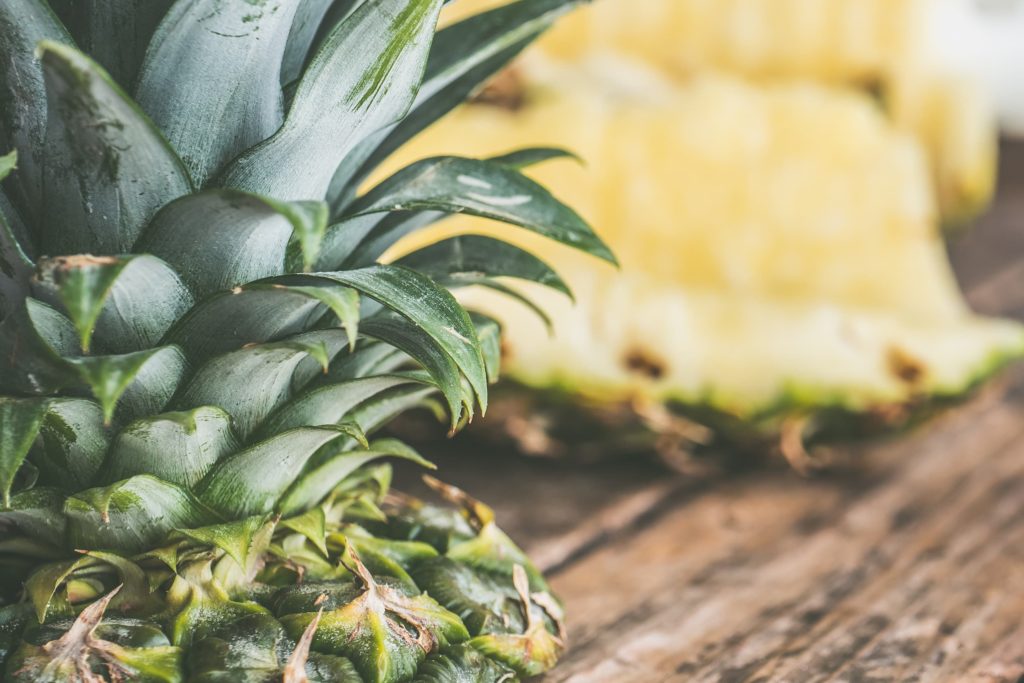
Believe it or not, the story of the pineapple pizza or Hawaiian pizza actually starts in Canada in the early 1960s.
Sam Panopoulos is generally credited with inventing pineapple pizza. He was born in Greece but moved to Canada when he was 20, and didn’t start making pizzas until he opened a restaurant in Chatham, Ontario in 1962. His original idea for adding pineapple to pizza came from his time spent in Hawaii, where he saw people putting fruit on their pizzas. He thought it would be a good idea to try it out himself, and it turns out he was right! The combination of sweet and savory flavors was a hit with his customers and quickly gained popularity.
The Hawaiian pizza was born.
How did pineapple on pizza become popular?
After Panopoulos introduced his new pineapple pizzas in Canada the new topping really started to take off all over the world in the 1970’s. In the 70’s people were starting to become more adventurous with their food, and wanted to move away from traditional toppings like pepperoni and sausage. Trying exotic foods was considered cool at the time, and if you actually enjoyed it you might even be consider sophisticated for being able to appreciate flavors that most people didn’t.
Pineapple as a pizza toping was low risk adventurous options, compared to let’s say, sushi, and so people were curious about this strange new combination, and were willing to give it a try. It wasn’t long before pineapple pizza was being served in restaurants all over the globe.
Why do some people hate pineapple on pizza?
There are a few different reasons why people might not like pineapple on their pizza. For some, it’s simply a matter of taste – they don’t like the way the sweetness of the pineapple interacts with the savory flavors of the pizza. Others might object to pineapple on principle, because they think that fruit doesn’t belong on a savory dish like pizza.
Whatever the reason, there’s no doubt that pineapple on pizza is one of the most controversial toppings out there. Love it or hate it, there’s just something about this combination that gets people talking!
Should you hate pineapple pizza?
The truth is no pizza should be hated.
The thing that makes pizza unique and has enabled it to literally conquer the world, is its versatility. From the very beginning pizza wasn’t defined as a concrete list of ingredients, it was defined as crust with a sauce and some toppings. This definition allowed everyone to make pizza their own and customize it to their liking. If the recipe for pizzas was a precise as the recipe for a cheese souffle we probably would not be able to find pizza in every country around the globe. Versatility is probably one of the keys to the international success of pizza.
Italians believe every pizza topping deserves to be considered, analyzed and challenged, and pineapple is no exception! Top Italian chefs have already listed pizzas with pineapple on their menus, and they’ve proved successful. So if not even Italians hate pineapple on pizza, why should you!?
When it comes to pizza, there are a lot of different ways in which you can customize your pie. Whether you like to keep things traditional with classic toppings, or prefer to get creative with unique ingredients, the possibilities are endless when it comes to topping your pizza!
To help you decide what to put on your next pizza, here is a list of some of the best pizza toppings, both classic and unique. With so many delicious options to choose from, you’re sure to find the perfect topping for your next pizza night!
Stay classic with those tried and true pizza toppings
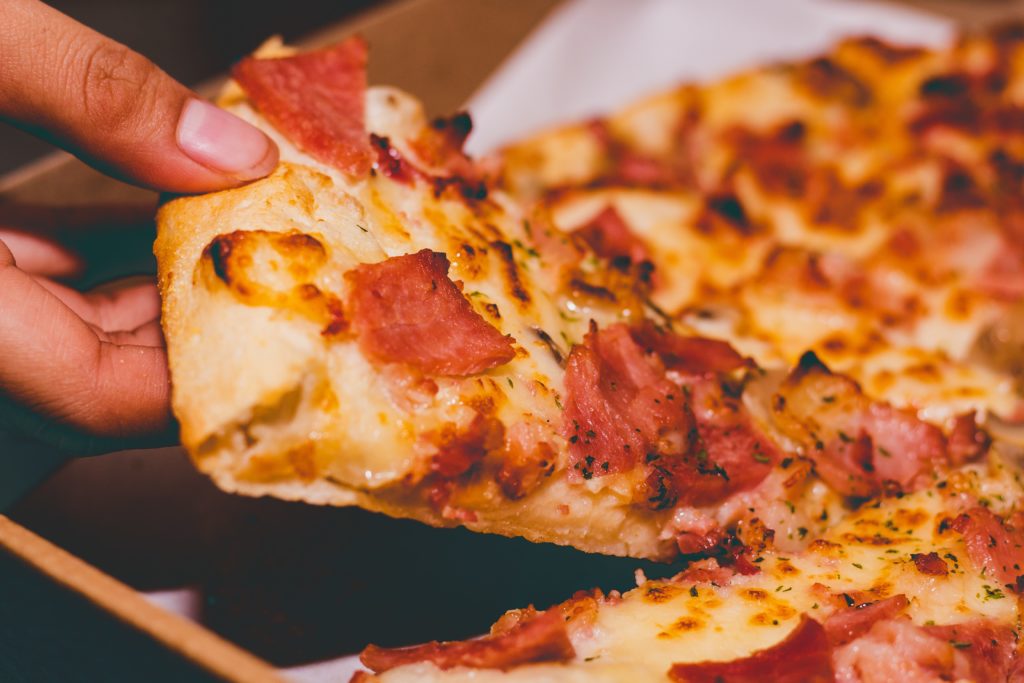
Pizza is a classic dish that can be made in countless ways. One of the best things about pizza is that you can top it with whatever you like, making it a perfect dish for everyone. If you’re looking for some inspiration for your next pizza night, here are some of the best classic pizza toppings that you can choose from!
Sauce is the first thing you want to choose in your pizza topping. To stay true to authentic Italian recipes, choose a homemade tomato sauce.
Pepperoni is a classic pizza topping that is loved by many. It’s the perfect combination of salty and spicy, and it goes great with cheese. If you’re looking for a traditional pizza experience, pepperoni is the way to go.
Ham is a delicious option if you’re looking for something different from the usual pepperoni and sausage. It’s a great way to add some extra protein to your meal, and it has a unique flavor that goes well with cheese, tomato sauce and basil.
Bacon is a delicious topping that can be used on both savory and sweet pizzas. It’s perfect for adding a bit of smoky flavor, and it goes great with cheese and tomatoes. If you’re looking for something a little different, try using Canadian bacon or pancetta.
And if you want to keep it light and vegetarian, a simple margherita pizza is always the way to go!
Try those unique and extravagant pizza toppings!
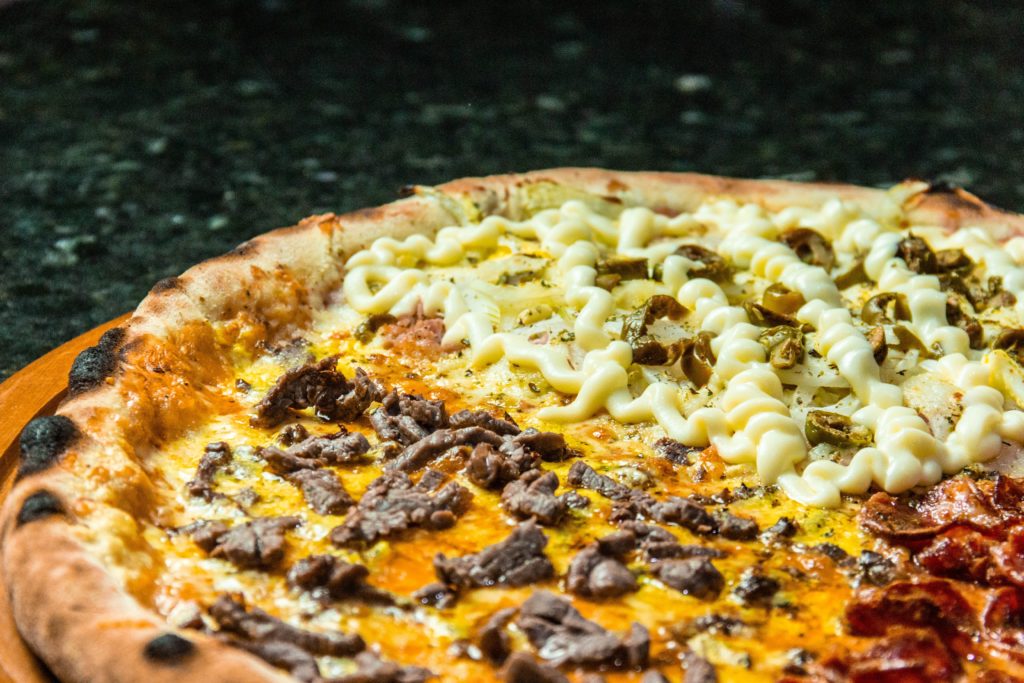
If you’re looking to really shake things up in the kitchen, why not try some unique and extravagant pizza toppings?
Seafood lovers can go for lobster or shrimp, for a more gourmet pizza.
For something a little more exotic, lamb, duck, or venison make excellent toppings. You can also travel to Hawaï with the traditional pineapple pizza: we know it’s a make or break but we’ll let you choose your team!
If you’re looking for a classic flavor combination that is sure to please, try a barbecue pizza. The sweetness of the barbecue sauce pairs perfectly with the smokiness of the meat, and the cheese pulls it all together. You can use any kind of meat you like, but chicken or pork are usually the best choices.
Looking for a plant-based pizza topping? There are plenty of options to choose from! Mushrooms, onions, peppers, and olives are all great choices that will add flavor and nutrition to your meal. If you’re looking for something a little different, try using artichokes, eggplants, sun-dried tomatoes, or spinach.
There are endless possibilities when it comes to pizza toppings, so don’t be afraid to get creative in the kitchen! With a little imagination, you can come up with some truly unique and delicious combinations. So go ahead and experiment – your taste buds will thank you.

